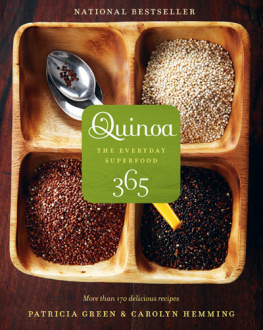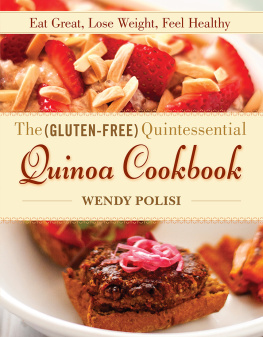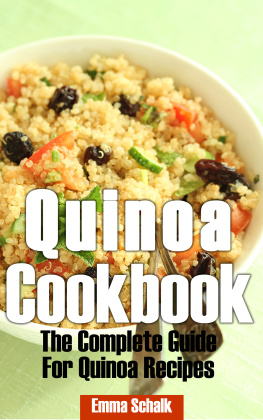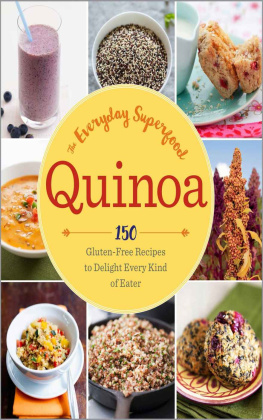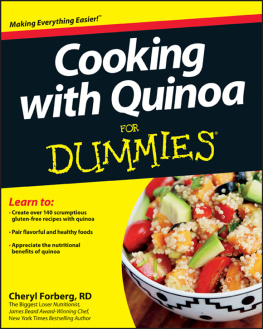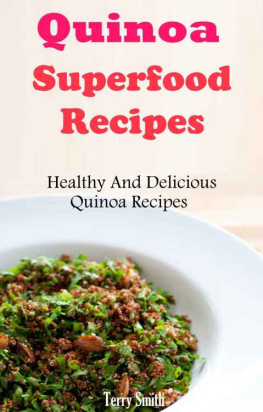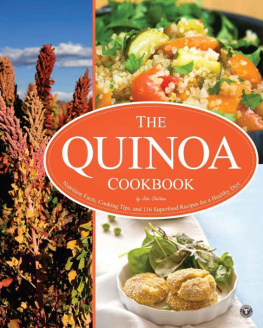QUINOA
REVOLUTION
QUINOA
REVOLUTION
Over 150 Healthy, Great-Tasting
Recipes Under 500 Calories
PATRICIA GREEN & CAROLYN HEMMING

This book is dedicated to every single one of our fellow quinoa lovers, especially fans and readers of Quinoa 365: The Everyday Superfood. Thank you for your questions, requests and absolute passion about quinoa.
ALSO BY
Patricia Green & Carolyn Hemming
Quinoa 365: The Everyday Superfood



CONTENTS

PREFACE
S INCE our first book, Quinoa 365: The Everyday Superfood, was released in early 2010, people have been sharing their quinoa stories with us, writing to tell us how quinoa is transforming their lives. Parents. Spouses. Whole families. Athletes. Weight-loss dieters. Vegetarians. Cancer survivors. Diabetics. Heart patients. People with food allergies. Those who are gluten-intolerant. Everyone seems to have a story about how they first learned about quinoa, how theyre now eating it, what they love about quinoa and how it is revolutionizing their life.
Many of you wrote to share your experiencesIve lost 15 pounds... Ive now got energy to exercise... I dont feel the need to snack like I used to... Gluten-intolerance has prevented me from eating great-tasting foods for years. Now I cant believe I can even eat delicious chocolate cake!... Ive improved my personal best triathlon time! And weve heard funny stories too, such as, The quinoa baking tasted so good my husband snatched it to take to poker night.
Today it seems quinoa is talked about everywhere. Television talk shows, radio, blogs, celebrities. Oprah recommends quinoa. Martha Stewart cooks with quinoa. Dr. Oz says to cleanse with quinoa. It is a common subject in books such as The 150 Healthiest Foods on Earth: The Surprising, Unbiased Truth about What You Should Eat and Why; Food Synergy: Unleash Hundreds of Powerful Healing Food Combinations to Fight Disease and Live Well; Power Aging; 101 Foods That Could Save Your Life!; Conscious Health: A Complete Guide to Wellness through Natural Means; What Your Doctor May Not Tell You about Diabetes; and Get Balanced: The Natural Way to Better Health with Superfoods.
More than ever, people are being watchful of unwanted processing of and chemicals in their food, choosing to be consciously aware of everything they are putting into their mouths. Increasing numbers of people are keeping close track of their nutrition to ensure theyre being calorie-smart and their bodies are getting the minerals and vitamins they need to stay healthy and prevent illness and disease. (With closer attention being paid to calories and nutritional content, we have added those values to each recipe in this book.)
The rising sales of quinoa have also brought attention to ensuring that nobody suffers any negative consequences from the increased demand. Sustainable, fair-trade growing programs now exist, and we have seen first-hand in Bolivia the positive results of quinoa farming. There, quinoa farming has given many farm families a sense of pride, allowing them to support each other as well as their communities.
Amid environmental concerns, quinoa has re-emerged as a practical alternative to other popular crops that cant be successfully grown in difficult conditions. It can be grown in adverse conditions with relatively little water, such as the high, rocky plateaus of Bolivia. Crops are rotated to maintain the integrity of the soil, and llamas are used to feed on quinoa stalks and further fertilize the soil.
So whether we consume quinoa for weight loss, gluten-intolerance, a vegetarian diet, allergy control, disease prevention, overall great health or any of its other numerous advantages, the positive outcomes of using this powerhouse superfood are extensive and far reaching. With even more recipes, we hope to bring the benefits of quinoa nutrition to your table and inspire you to find many delicious ways to revolutionize your health. As always, were open to hearing your feedback, ideas and great stories of your quinoa adventures.
INTRODUCTION
Revolutionizing Health & Fitness with Quinoa
By Laurie A. Scanlin, Ph.D., & Claire Burnett, MS
Q UINOA boasts the highest nutrition profile of all grains (because its not a grain!) and is the fastest to cook, a prerequisite for almost everyone these days. Most important, whether nutritious food is eaten for boosting health, preventing illness, reaching top athletic performance or for pure pleasure, it should taste good. This book takes a step further into the full advantages of quinoa with recipes for delicious, easy-to-make dishes that nourish. Carolyn and Patricia combine quinoas appealing taste, versatility and light texture with a variety of fresh vegetables, fruits, legumes, nuts, healthy oils and lean proteins in over 150 tasty recipes, all under 500 calories per serving.
Quinoas long list of distinguishing traits means there are many benefits to incorporating it into any lifestyle. Dedicated athletes are using it pre and post workout, vegetarians eat it as a source of non-animal protein, those with celiac disease benefit from its being gluten-free, those looking to detoxify or lose weight eat it because of its antioxidants, rich fiber, lean protein and complex carbohydrates. Diabetics, heart patients, those healing from cancer and those who simply choose quinoa as a dietary staple for overall improved health all benefit from quinoa. There is no question quinoa has the power to help many on a large scale and to completely revolutionize what we eat.
Unlike most of todays highly refined crops that have been genetically engineered or selectively bred and monocropped, quinoa does not require this. It is naturally genetically complex. One advantage of its genetic complexity is its ability to withstand harsh climates, where other crops fail to grow at all. The extreme mountain terrain where quinoa thrives is as rugged and hardy as quinoa iswhich translates into superior nutrition. And that nutritional powerhouse explains why quinoa started to gain attention and began to be exported from South America over thirty years ago. Awareness of this superfood continues, and in 2011 alone, the market for quinoa rose 40 percent, as everyone from health-conscious consumers to athletes added quinoa to their diets.
QUINOAS STRUCTURE
In order to better understand this superfood, its helpful to know what quinoa is rather than what it is not. Although it looks like a cereal grain, quinoa is not a grain. True cereal grains, such as wheat, corn, barley and rice, are seeds of the single-leaf grass family (or monocotyledons). Quinoa is a seed of the double-leaf vegetable family (or dicotyledons). Specifically it is the seed of a broad-leaf plant in the family Chenopodiaceae, which also includes spinach and beets. Quinoas difference from cereal grains is significant when it comes to superior nutrition and hypoallergenic proteins. Quinoa seeds consist of three basic parts: an outer pericarp, or bran layer; an internal perisperm, a mass of storage tissue that provides carbohydrates and energy; and a large embryo, or germ (the equivalent of an egg yolk). Quinoa germ is high in albumin protein. Similar to the way egg albumin whitens, during cooking the germ sprouts from the seed and becomes visible as a white spiral around each cooked seed. These three basic components give quinoa its distinguishing nutritional traits that fit the special dietary needs of so many consumers.
Next page

